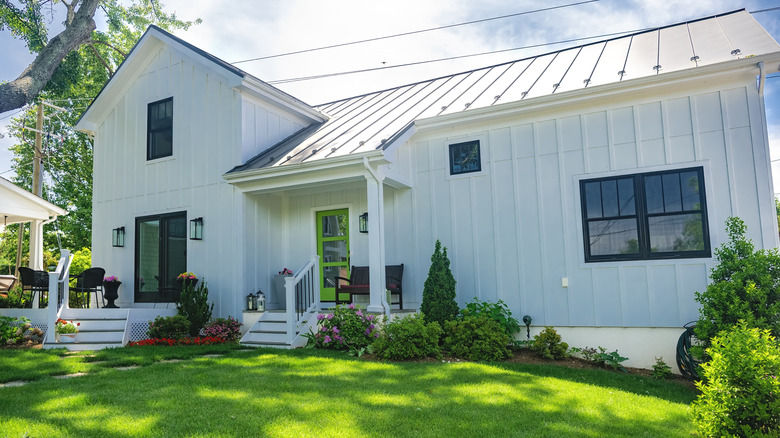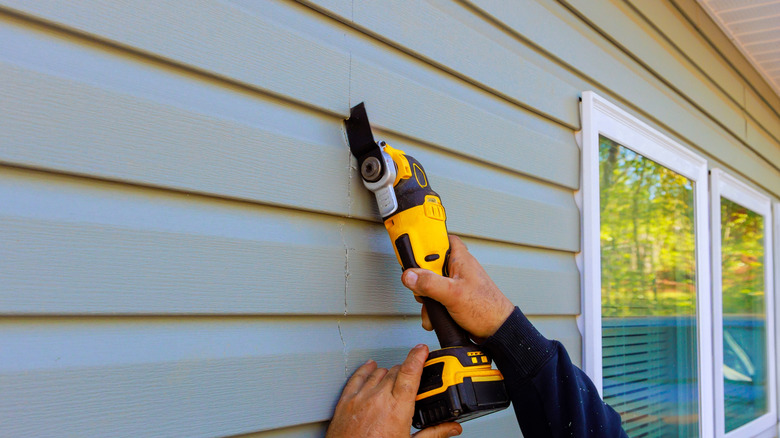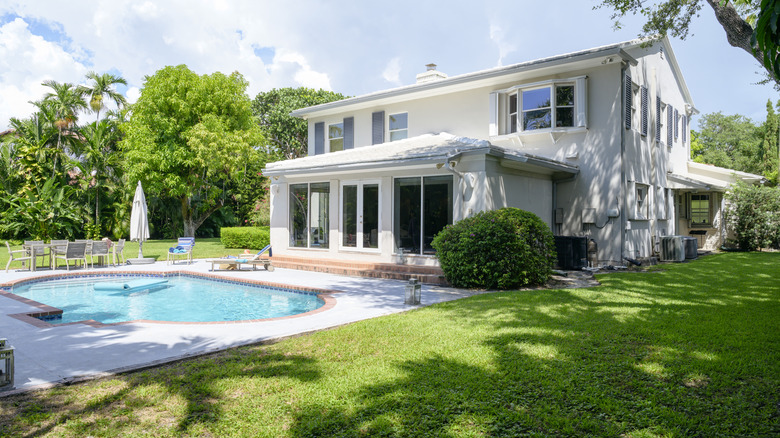The Backyard Home Trend That Needs To Go (And What We Recommend Instead)
If you've been a DIY-er or home renovator for a while, you know that netizens often have strong opinions on design trends. Whether they're mad about painting over a brick fireplace or cancelling the all-white aesthetic, there always seem to be rising qualms in the zeitgeist. The newest on the list is vinyl siding, which has recently been denounced on the internet due to its polarizing aesthetic. Vinyl siding can indeed have a mullet effect on a house: business in the front where the brick and mortar is, and party in the back where the cheaper vinyl lives. We talked to an expert who agrees that vinyl siding needs to go, and said that homeowners can use fiber cement, brick veneer, or high-quality engineered wood siding in its place.
Judi Kutner, licensed realtor, staging expert, and senior contributor at Virtual Staging, spoke exclusively with House Digest about the pros and cons of vinyl siding, and what materials to use instead. One thing that's clear about this type of cladding is that it's super popular in the United States. "Cheap vinyl siding is quite a common thing to see, partly because in the U.S. there is a strong emphasis on affordability and building homes quickly, something which vinyl siding can be very handy for," Kutner said. The material is so popular that, in 2022, over 26% of new homes were found to have used vinyl siding as the primary cladding material. This was especially true in the Midwest and Northeast, where vinyl was the most-used material in new builds.
Benefits to vinyl siding
So, why is vinyl so popular? In her exclusive interview with House Digest, Kutner said, "I think the main reason is money, but often people might only concern themselves with making the front of their property beautiful and they then 'forget' about the back," Kutner explained. It's no secret that vinyl is a low-cost material due to its synthetic nature, so substituting bricks for vinyl at the back of a house is a sensible way for homeowners to cut costs.
Affordability is combined with the fact that vinyl is typically easy to install. "With so many new buildings going up it makes sense that it is everywhere," she added. However, this cost-cutting material could incur more loss for homeowners in the future, and there are multiple disadvantages to vinyl siding you'll wish you knew sooner. "But for me personally, I'm not a huge fan of this 'trend,' just because it disrupts the overall harmony and design integrity of a property, reducing the overall look and potentially the value when it comes to selling," Kutner told us.
Cladding materials to use instead of vinyl
There are plenty of other cladding materials worth looking into if you want to increase the value and durability of your home — and to avoid the design faux pas. Kutner laid out the options exclusively for House Digest. "Instead of cheap vinyl siding, I recommend using fiber cement, brick veneer, or high-quality engineered wood siding," she said. "These materials provide a more durable and visually cohesive look that complements the front of the home while enhancing long-term value." Of course, for cohesion's sake, you can opt to use the same material around every part of the house. However, if that's out of the budget, these three are the way to go.
Fiber cement siding is a suitable option, according to Kutner, because of its wood-like aesthetic and durability. "It also requires less maintenance than natural wood and lasts significantly longer than vinyl," Kutner told us. Meanwhile, for homeowners that want to save costs on the back of their home, brick veneer is a good option that ensures architectural cohesion while costing less than brick construction. And finally, engineered wood is another cost-effective cladding option that still looks nice. "For a warmer, more natural aesthetic, engineered wood siding offers the rich appearance of traditional wood but with greater resistance to moisture and decay. It bridges the gap between affordability and luxury, ensuring the home looks thoughtfully designed from every angle," Kutner said.
How to level-up your backyard
One of the biggest qualms with vinyl siding is simply that it makes the back of a home look less enticing compared to the front. However, if your home already has vinyl in the back, you don't need to spend thousands of dollars building a brick wall just to have it match the front. An easy fix here — if you're still able to spend a smaller budget on replacing the vinyl — is to have the cheaper materials listed above match the facade. "One simple tip is to make sure that anything you put on the back, compliments the front," Kutner told House Digest exclusively. "For example, if your home has a brick or stone front, consider using brick veneer, fiber cement, or engineered wood siding in a coordinating color to create a seamless transition."
The final option, according to Kutner, is simply to invest in other parts of your backyard. "If you already have vinyl siding, then think about the landscaping of your garden. Could you get creative with an outdoor living space, or decorate your garden in a way that could distract people from looking at the exterior of your home?" You can lean into gorgeous landscaping ideas that will liven up your yard and even add tall greenery that covers some of the siding, so that your guests' eyes are drawn to more appealing features. As Kutner put it: "If you create an inviting space in your garden, people won't be looking at your siding."



